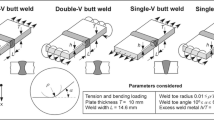Abstract
A method for the determination of weight functions relevant to welded joints and subsequent calculation of stress intensity factors is presented. The weight function for edge cracks emanating from the weld toe in a T-butt welded joint has been derived by using the Petroski-Achenbach crack opening displacement function. The weight function makes it possible to study efficiently the effect of weld profile parameters, such as the weld toe radius and weld angle, on stress intensity factors corresponding to different stress systems.
The method enables relatively easy calculations of stress intensity factors for welded T-butt joints for a variety of geometry and loading configurations. It was also found that the local weld geometric parameters affect the stress intensity factor more than the local stress fields in the weld toe neighbourhood.
Résumé
On présente une méthode de détermination des fonctions pondérées relatives à des joints soudés, et de calcul subséquent de facteurs d'intensité de contrainte.
Dans le cas de fissure de bords émanant de la racine de la soudure dans un joint d'angle, la fonction pondérée a été déterminée en utilisant la fonction COD de Petroski-Achenbach. Cette fonction permet détudier de manière efficace les effets des paramètres géométriques afférant au profil de la soudure, tels que le rayon à la racine et l'angle du cordon, sur les facteurs d'intensité de contraintes correspondant à diverses conditions de sollicitation.
La méthode permet de procéder à des calculs relativement simples des facteurs d'intensité de contraintes pour ce type de soudures, pour différentes géométries et configurations de mise en charge.
On trouve également que les paramètres de géométrie locale d'une soudure ont une influence plus prononcée sur le facteur d'intensité de contrainte que les champs de contraintes locales qui règnent dans la région de sa racine
Similar content being viewed by others
References
H. Tada, P. Paris and G. Irwin: The Stress Analysis of Cracks Handbook, Del Research Corporation, St Louis, Missouri (1973).
D.P. Pook and D.J. Cartwright: Compendium of Stress Intensity Factors, The Hillington Press, Uxbridge (1976).
I.F. Smith: in Proceedings of the 3rd International Conference on Numerical Methods in Fracture Mechanics, A.R. Luxmoore, D.R.J. Own (eds), Pineridge Press, Swansea, UK (1984) pp 561–574.
J.D. Burk and F.V. Lawrence: Welding Journal 56, No. 2 (1977) 43s-51s.
G. Glinka: in ASTM STP 677, Fracture Mechanics-Proceedings of the 11th National Symposium of Fracture Mechanics, C.W. Smith (ed.), American Society for Testing and Materials, Philadelphia (1979) pp 198–214.
G.E. Nordmark, L.N.M. Mueller and R.A. Kelsey: in ASTM STP 776, Residual Stress Effects in Fatigue, J.F. Throop and H.S. Reemsnyder (eds.), American Society for Testing and Materials, Philadelphia (1982) 44–62.
G. Glinka, Z. Gmur and Z. Swiderski: Engineering Fracture Mechanics 20, No. 1 (1984) 103–112.
X.R. Wu: Engineering Fracture Mechanics 19, No. 3 (1984) 427–439.
H.F. Bueckner: ZAMM 50, No. 9 (1970) 529–546.
J.R. Rice: International Journal of Solids and Structures 8 (1972) 751–758.
G. Glinka: in Advances in Surface Treatment, Vol. 4-Residual Stresses, A. Niku-Lari (ed.), Pergamon Press, UK (1987) 413–454.
A.P. Parker: in ASTM STP 776, Residual Stress Effects in Fatigue, J.F. Throop and H.S. Reemsnyder (eds.), American Society for Testing and Materials, Philadelphia (1982) 13–31.
H.J. Petroski and J.D. Achenbach: Engineering Fracture Mechanics 10, No. 2 (1978) 257–266.
H.F. Bueckner: Z. Angweandte Mathemat. Mechan 51 (1971) 97–109.
N. Hasebe and M. Ueda: Bulletin of the JSME 24, No. 189 (1981) 483–488.
N. Hasebe and S. Matsuura: Engineering Fracture Mechanics 20, No. 3 (1984) 447–462.
L.F. Impellizzeri and D.L. Rich: in ASTM STP 595, Fatigue Crack Growth Under Spectrum Loads, American Society for Testing and Materials, Philadelphia (1976) 320–336.
A.F. Grandt: International Journal of Fracture 11, No. 2 (1975) 283–294.
F. Görner, C. Matheck and P. Moraweitz: Engineering Fracture Mechanics 22, No. 2 (1985) 268–277.
X. Niu and G. Glinka: Engineering Fracture Mechanics (1987) (to be published).
J. Schijve: Fatigue of Engineering Materials and Structures 5, No. 2 (1982) 325–332.
G. Glinka: Engineering Fracture Mechanics 22, No. 5 (1985) 839–854.
M. Creager and P. Paris: International Journal of Fracture Mechanics 3, No. 2 (1967) 247–252.
R.I. Stephens and G. Glinka: Experimental Mechanics 20, No. 1 (1980) 24–30.
K. Yamada and M.A. Hirt: Journal of the Structural Division, ASCE 108, No. ST7 (1982) 1526–1540.
G. Glinka and A. Krzyżecki: Fatigue of Engineering Materials and Structures 4, No. 1 (1981) 35–48.
W.D. Dover, G. Glinka and R. Collins: in Non-Destructive Testing in the Fitness-For-Purpose Assessment of Welded Costructions-Conference Papers, J. Sanders (ed.), The Welding Institute, Cambridge (1984) pp 1–19.
M. Skorupa and A. Skorupa: Theoretical and Applied Fracture Mechanics 6, No. 1 (1986) 1–10.
Author information
Authors and Affiliations
Rights and permissions
About this article
Cite this article
Niu, X., Glinka, G. The weld profile effect on stress intensity factors in weldments. Int J Fract 35, 3–20 (1987). https://doi.org/10.1007/BF00034531
Received:
Accepted:
Issue Date:
DOI: https://doi.org/10.1007/BF00034531




